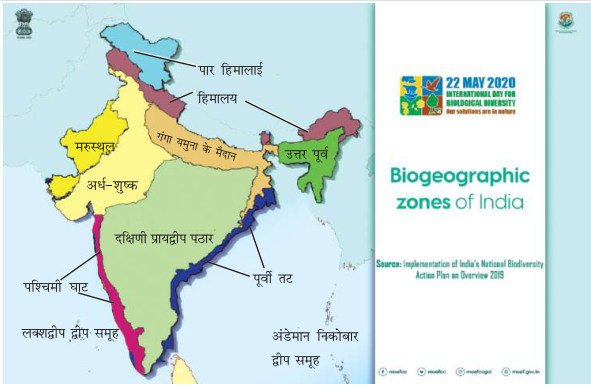Light Reflection and Refraction – Textbook Exercise Questions
1. Which of the following materials cannot be used to make a lens?
(d) Clay.
A lens must be made of a transparent material that allows light to pass through it. Water, glass, and plastic are transparent, but clay is opaque (it does not let light pass through).
2. The image formed by a concave mirror is observed to be virtual, erect and larger than the object. Where should be the position of the object?
(d) between the pole of the mirror and its principal focus.
This is the only position where a concave mirror forms a virtual, erect, and magnified image, which is how it is used as a shaving mirror or a makeup mirror.
3. Where should an object be placed in front of a convex lens to get a real image of the size of the object?
(b) at twice the focal length of the lens.
When an object is placed at a distance of 2F (twice the focal length) from a convex lens, a real, inverted image of the same size is formed at 2F on the other side.
4. A spherical mirror and a thin spherical lens have each a focal length of -15 cm. The mirror and lens are likely to be:
(a) both are concave.
According to the sign convention, a negative focal length indicates that both the mirror and the lens are concave.
5. No matter how far you stand from a mirror, your image appears erect. The mirror is likely to be:
(d) either plane or convex.
A plane mirror always forms an erect image of the same size. A convex mirror always forms an erect and diminished (smaller) image. A concave mirror only forms an erect image when the object is very close to it.
6. Which of the following lenses would you prefer to use while reading small letters in a dictionary?
(c) A convex lens of focal length 5 cm.
To read small letters, you need a magnifying glass, which is a convex lens. A lens with a shorter focal length has a greater power (magnification). Therefore, the 5 cm focal length convex lens will provide more magnification than the 50 cm one.
7. We wish to obtain an erect image of an object, using a concave mirror of focal length 15 cm. What should be the range of distance of the object from the mirror? What is the nature of the image? Is the image larger or smaller than the object? Draw a ray diagram to show the image formation in this case.
-
Range of distance: To get an erect image, the object must be placed between the pole (P) and the principal focus (F) of the mirror. So, the range of distance is between 0 cm and 15 cm from the mirror.
-
Nature of the image: The image formed is virtual and erect.
-
Size of the image: The image is larger than the object (magnified).

8. Name the type of mirror used in the following situations:
(a) Headlight of a car: Concave mirror. It is used to reflect the light from the bulb into a powerful, parallel beam.
(b) Side/rear-view mirror of a vehicle: Convex mirror. It gives a wider field of view, allowing the driver to see more of the traffic behind them.
(c) Solar furnace: Concave mirror. A large concave mirror is used to concentrate sunlight at a single point to produce intense heat.
9. One half of a convex lens is covered with a black paper. Will this lens produce a complete image of the object? Explain your observation.
Yes, the lens will still produce a complete image of the object. However, the brightness of the image will be reduced. This is because a complete image is formed by the convergence of rays from all points of the lens. When half the lens is covered, the number of light rays passing through is reduced, making the image dimmer, but the remaining rays still form the full image.
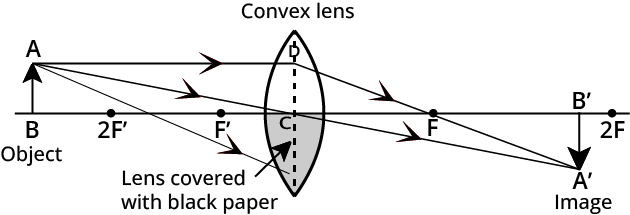
OR
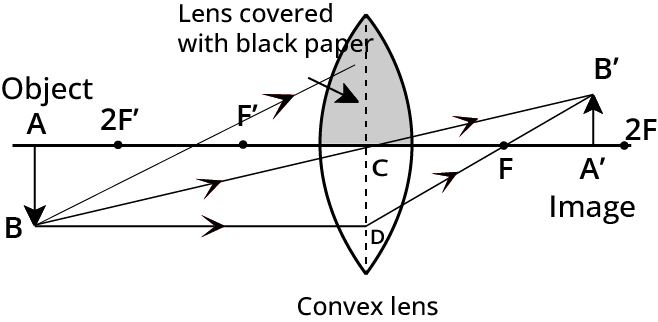
10. An object 5 cm in length is held 25 cm away from a converging lens of focal length 10 cm. Draw the ray diagram and find the position, size and the nature of the image formed.
Given:
-
Object height (h₀) = +5 cm
-
Object distance (u) = -25 cm
-
Focal length (f) = +10 cm (since it’s a converging/convex lens)
To Find: Image distance (v), image height (hᵢ), and nature of the image.
Solution:
-
Find the image position (v) using the lens formula:
1/f = 1/v – 1/u
1/10 = 1/v – 1/(-25)
1/10 = 1/v + 1/25
1/v = 1/10 – 1/25
1/v = (5 – 2) / 50 = 3/50
v = 50 / 3 = +16.67 cm -
Find the image size (hᵢ) using the magnification formula:
m = hᵢ / h₀ = v / u
hᵢ / 5 = 16.67 / (-25)
hᵢ = (16.67 / -25) * 5
hᵢ = -3.33 cm
Conclusion:
-
Position: The image is formed at 16.67 cm on the opposite side of the lens.
-
Size: The image is 3.33 cm tall.
-
Nature: Since ‘v’ is positive, the image is real. Since ‘hᵢ’ is negative, the image is inverted.
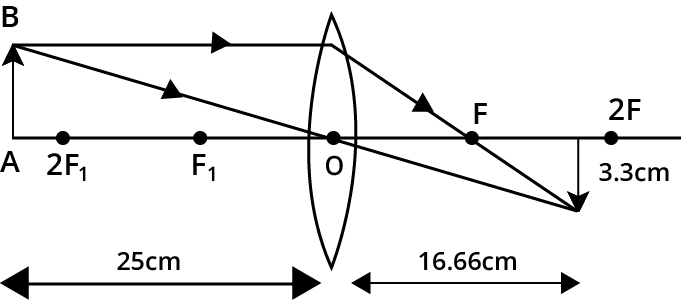
11. A concave lens of focal length 15 cm forms an image 10 cm from the lens. How far is the object placed from the lens?
Given:
-
Focal length (f) = -15 cm (concave lens)
-
Image distance (v) = -10 cm (a concave lens always forms a virtual image on the same side as the object)
To Find: Object distance (u).
Solution:
-
Use the lens formula:
1/f = 1/v – 1/u
1/(-15) = 1/(-10) – 1/u
1/u = 1/(-10) – 1/(-15)
1/u = -1/10 + 1/15
1/u = (-3 + 2) / 30 = -1/30
u = -30 cm
Conclusion: The object is placed 30 cm from the lens.
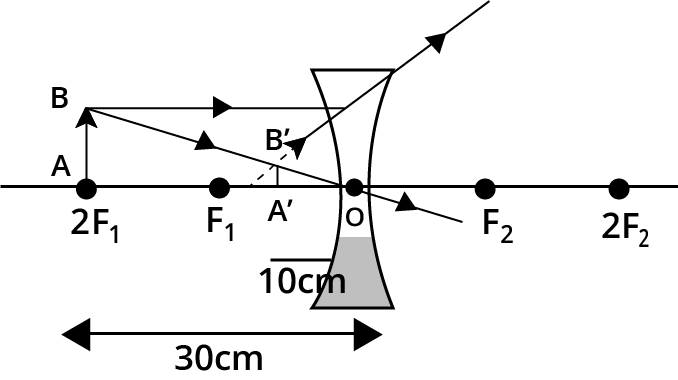
12. An object is placed at a distance of 10 cm from a convex mirror of focal length 15 cm. Find the position and nature of the image.
Given:
-
Object distance (u) = -10 cm
-
Focal length (f) = +15 cm (convex mirror)
To Find: Image distance (v) and nature.
Solution:
-
Use the mirror formula:
1/f = 1/v + 1/u
1/15 = 1/v + 1/(-10)
1/v = 1/15 + 1/10
1/v = (2 + 3) / 30 = 5/30 = 1/6
v = +6 cm
Conclusion:
-
Position: The image is formed 6 cm behind the mirror.
-
Nature: Since ‘v’ is positive for a mirror, the image is virtual and erect.
13. The magnification produced by a plane mirror is +1. What does this mean?
This means:
-
The ‘+’ sign indicates that the image is erect (upright).
-
The number ‘1’ indicates that the size of the image is equal to the size of the object.
14. An object 5.0 cm in length is placed at a distance of 20 cm in front of a convex mirror of radius of curvature 30 cm. Find the position of the image, its nature and size.
Given:
-
Object height (h₀) = +5.0 cm
-
Object distance (u) = -20 cm
-
Radius of curvature (R) = +30 cm (convex mirror)
To Find: Image distance (v), nature, and image height (hᵢ).
Solution:
-
First, find the focal length (f):
f = R / 2 = 30 / 2 = +15 cm -
Find the image position (v) using the mirror formula:
1/f = 1/v + 1/u
1/15 = 1/v + 1/(-20)
1/v = 1/15 + 1/20
1/v = (4 + 3) / 60 = 7/60
v = 60 / 7 = +8.57 cm -
Find the image size (hᵢ) using the magnification formula:
m = hᵢ / h₀ = -v / u
hᵢ / 5 = -(8.57) / (-20)
hᵢ = (8.57 / 20) * 5
hᵢ = +2.14 cm
Conclusion:
-
Position: The image is 8.57 cm behind the mirror.
-
Nature: Since ‘v’ is positive, the image is virtual. Since ‘hᵢ’ is positive, it is erect.
-
Size: The image is 2.14 cm tall.
15. An object of size 7.0 cm is placed at 27 cm in front of a concave mirror of focal length 18 cm. At what distance from the mirror should a screen be placed? Find the size and the nature of the image.
Given:
-
Object height (h₀) = +7.0 cm
-
Object distance (u) = -27 cm
-
Focal length (f) = -18 cm (concave mirror)
To Find: Image distance (v), image height (hᵢ), and nature.
Solution:
-
Find the image position (v) using the mirror formula:
1/f = 1/v + 1/u
1/(-18) = 1/v + 1/(-27)
1/v = 1/(-18) – 1/(-27) = -1/18 + 1/27
1/v = (-3 + 2) / 54 = -1/54
v = -54 cm -
Find the image size (hᵢ) using the magnification formula:
m = hᵢ / h₀ = -v / u
hᵢ / 7 = -(-54) / (-27)
hᵢ / 7 = -2
hᵢ = -2 * 7 = -14.0 cm
Conclusion:
-
Screen Position: The screen should be placed at 54 cm in front of the mirror (since ‘v’ is -54 cm).
-
Size: The image is 14.0 cm tall.
-
Nature: Since ‘v’ is negative, the image is real. Since ‘hᵢ’ is negative, it is inverted.
16. Find the focal length of a lens of power –2.0 D.
Given: Power (P) = -2.0 D
Formula: Focal length in meters, f = 1 / P
Solution: f = 1 / (-2.0) = -0.5 m or -50 cm.
17. A doctor has prescribed a corrective lens of power +1.5 D. Find the focal length of the lens.
Given: Power (P) = +1.5 D
Formula: f = 1 / P
Solution: f = 1 / 1.5 = +0.67 m or +66.7 cm.
In-text Questions
18. Define the principal focus of a concave mirror.
The principal focus of a concave mirror is a point on its principal axis where rays of light that are parallel to the principal axis converge (meet) after being reflected by the mirror.
19. The radius of curvature of a spherical mirror is 20 cm. What is its focal length?
Given: Radius of curvature (R) = 20 cm
Formula: Focal length, f = R / 2
Solution: f = 20 / 2 = 10 cm.
20. Name a mirror which can give an erect and enlarged image of an object.
A concave mirror can give an erect and enlarged image when the object is placed between the pole and the principal focus.
21. Why do we prefer a convex mirror as a rear-view mirror in vehicles?
We prefer a convex mirror for two main reasons:
-
It always provides an erect image of the objects behind.
-
It has a wider field of view than a plane mirror of the same size, allowing the driver to see a larger area of the traffic behind.
22. Find the focal length of a convex mirror whose radius of curvature is 32 cm.
Given: Radius of curvature (R) = 32 cm
Formula: f = R / 2
Solution: f = 32 / 2 = 16 cm.
23. A concave mirror produces a three times magnified (enlarged) real image of an object placed at 10 cm in front of it. Where is the image located?
Given:
-
Magnification (m) = -3 (it is negative because the image is real and therefore inverted)
-
Object distance (u) = -10 cm
Formula: m = -v / u
Solution:
-3 = -v / (-10)
-3 = v / 10
v = -3 * 10 = -30 cm
Conclusion: The image is located 30 cm in front of the mirror.
24. A ray of light travelling in air enters obliquely into water. Does the light ray bend towards the normal or away from the normal? Why?
The light ray will bend towards the normal. This is because it is travelling from a rarer medium (air) to a denser medium (water), which causes the speed of light to decrease.
25. Light enters from air to glass having a refractive index of 1.50. What is the speed of light in the glass? The speed of light in a vacuum is 3 × 10⁸ m/s.
Given:
-
Refractive index of glass (n) = 1.50
-
Speed of light in vacuum (c) = 3 × 10⁸ m/s
Formula: n = c / v (where v is the speed of light in the medium)
Solution:
1.50 = (3 × 10⁸ m/s) / v
v = (3 × 10⁸ m/s) / 1.50
v = 2 × 10⁸ m/s
26. Find out from Table 10.3 of the textbook, the medium having the highest optical density. Also find the medium with the lowest optical density.
The medium with the highest optical density is the one with the highest refractive index, which is Diamond (n = 2.42).
The medium with the lowest optical density is the one with the lowest refractive index, which is Air (n = 1.0003).
27. The refractive indices of kerosene, turpentine, and water are 1.44, 1.47, and 1.33 respectively. In which of these materials does light travel the fastest?
Light travels fastest in the medium with the lowest refractive index. Therefore, light travels fastest in water (n = 1.33).
28. The refractive index of diamond is 2.42. What is the meaning of this statement?
This statement means that the ratio of the speed of light in a vacuum to the speed of light in diamond is 2.42. In simpler terms, it means light travels 2.42 times slower in diamond than it does in a vacuum.
29. Define 1 dioptre of power of a lens.
One dioptre is defined as the power of a lens that has a focal length of 1 meter.
30. A convex lens forms a real and inverted image of a needle at a distance of 50 cm from it. Where is the needle placed in front of the convex lens if the image is equal to the size of the object? Also, find the power of the lens.
Analysis: For a convex lens, an image is the same size as the object only when the object is placed at 2F, and the image is formed at 2F on the other side.
Given:
-
Image distance (v) = +50 cm
-
Image size = Object size, so the image is at 2F.
Solution:
-
Find the focal length (f):
2F = 50 cm
F = 50 / 2 = 25 cm -
Find the object position (u):
The object must be placed at 2F, so u = 50 cm in front of the lens. -
Find the power (P):
-
First, convert focal length to meters: f = 25 cm = 0.25 m.
-
Power, P = 1 / f
-
P = 1 / 0.25 = +4.0 D.
-
31. Find the power of a concave lens of focal length 2 metres.
Given: Focal length (f) = -2 m (focal length is negative for a concave lens)
Formula: P = 1 / f
Solution: P = 1 / (-2) = -0.5 D.


